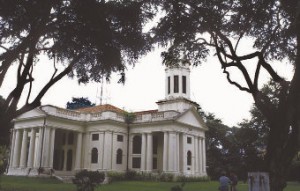Pateel Mekhitarian
Staff Writer

On Tuesday, April 21, Dr. George Bournoutian presented his third and final lecture in a series on the Armenian Churches of Persia, Russia, and South Asia. The lecture covered the many areas in South Asia where Armenian churches exist and are maintained. Dr. Bournoutian accompanied his talk with slides that he had taken during his numerous trips to the region.
Many of the churches, including Holy Etchmiadzin, the headquarters of the Armenian Church, show the artistic influence of Armenia’s neighbors. Over the years, due to war and hardships, Etchmiadzin had been neglected and when it was renovated and redecorated in the seventeenth century, the Persian influence was very strong. From 1600-1800 many Armenian churches were constructed in a number of South Asian cities, such as Delhi, Bombay (Mumbai), Madras (Chennai), and Calcutta (Kolkata). Holy Nazaret church in Kolkata is the oldest church in India, and while it does not look like a traditional Armenian church, the dome is of an Armenian style.
Calcutta had many Armenians who settled in the area, creating the largest Armenian community in India, with about 4-5,000 Armenians having lived there at one time. Today, there are only some 200 Armenians left in Calcutta. A major street in the city is now known as “Armenian Street,” and a resident priest from Etchmiadzin is responsible for all Armenian churches in South Asia.
The Armenians living in India were greatly influenced by the British merchants, who came to the area to establish trade agreements. Both Indians and Armenians were increasingly influenced by the British throughout the years, for example, Armenians started changing their names, from Davidian to simply David. In addition, Armenian gravestones began to be written in English, instead of Armenian.
The Armenian Sports Club and the Armenian College in India are still open and active today. Students from Lebanon, Cyprus, Armenia, Iran, and other countries travel to study at the Armenian College and Philanthropic Academy, whose curriculum is based on the British educational system.
Bombay’s Armenian community only has twelve to fourteen Armenians, most of who intermarried with the British or Indians. There is a commercial building in Bombay, called Ararat, and the money collected from rents is donated to the Armenian Church.
In Bangladesh, there is a beautiful church built with three large church bells. In the nineteenth and early twentieth centuries the city had many Armenians, who produced 85% of the jute, which is a material used for burlap and ropes. The Armenians became wealthy through the jute trade.
The church in Bangladesh has an octagonal dome, executed in an Armenian style. Until today, a caretaker is responsible for maintaining the church and he resides in a house directly next to the Church. Names here also started changing, for example, Haroutoun Krikor Simonian became Arratoon Gregory Simeon. Today, there is only a single Armenian living in Bangladesh.
Singapore is another country that was once home to a large Armenian community. A huge church was built in 1835 and is currently extremely well maintained and restored thanks to the former Armenian ambassador in Thailand. The church is so large and beautiful that non-Armenians, such as the Koreans, often wed at the church. There is a plaque in front of the church, recognizing the building as the Church of St. Gregory the Illuminator.
Surprisingly,Shanghai, China, is another location where Armenians have settled. In the past, there have been a number of buildings owned by Armenian people, however due to countless renovations and advances, the city of Shanghai has changed and many of these buildings are no longer in existence.
There once was a large and beautiful Armenian church in Jakarta, Indonesia and a smaller one in Surabaya. Unfortunately, the government purchased the Jakarta church and demolished it, donating the money to the Armenians. Currently, there are about twenty Armenians left in Indonesia.
Armenians have migrated to many different areas of the world and whether the Armenians relocated for economic, political, or family reasons, they managed to maintain a strong relationship with their faith. Although they were far away from their Motherland, the Armenians built churches everywhere they went, staying true to their roots. The Armenian people deeply cherish their Christian faith and due to their strong bond, they have maintained their unique identity over time.
 Hye Sharzhoom Armenian Action
Hye Sharzhoom Armenian Action